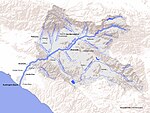Fort Benson was a Fort built in 1856 in present-day Colton in San Bernardino County, California. The Fort is named for its builder, Jerome Benson. The Fort was abandoned a year after it was built in 1857. Fort Benson was designated a California Historic Landmark (No.617) on September 11, 1957. Jerome Benson, in fear, built the Fort because of land disputes. The fort on his land claim, was made of earthworks and wood. The fort was defended by a brass cannon. The fort was used only one year as about half the Mormons around his land were told to return to Utah during the Mormon War, also call the Utah War.
On December 27, 1858, the US Army arrived into San Bernardino. The US Army's Mojave Expedition leader was Colonel William Hoffman. He placed troops in San Bernardino and Cajon Pass to deal with Indians and the land problems. Fort Benson is gone and only a marker is at the spot of the fort.
The Utah War (1857–1858) was an armed confrontation between Mormon settlers in the Utah Territory and the armed forces of the United States government. The confrontation lasted from May 1857 to July 1858. There were some casualties, mostly non-Mormon civilians. The war had no notable military battles. the Mormon War, or the Mormon Rebellion In 1857–1858, President James Buchanan sent U.S. forces to the Utah Territory in what became known as the Utah Expedition. The Mormons, fearful that the large U.S. military force had been sent to annihilate them and having faced persecution in other areas, made preparations for defense. Though bloodshed was to be avoided, and the U.S. government also hoped that its purpose might be attained without the loss of life, both sides prepared for war. The Mormons manufactured or repaired firearms, turned scythes into bayonets, and burnished and sharpened long-unused sabres.The Aiken massacre took place the following month. In October 1857, Mormons arrested six Californians traveling through Utah and charged them with being spies for the U.S. Army. They were released, but were later murdered and robbed of their stock and $25,000.
Taking all incidents into account, MacKinnon estimates that approximately 150 people died as a direct result of the year-long Utah War, including the 120 migrants killed at Mountain Meadows. He points out that this was close to the number of people killed during the seven-year contemporaneous struggle in "Bleeding Kansas". In the end, negotiations between the United States and the Latter-day Saints resulted in a full pardon for the Mormons (except those involved in the Mountain Meadows murders), the transfer of Utah's governorship from church President Brigham Young to non-Mormon Alfred Cumming, and the peaceful entrance of the U.S. Army into Utah.
Jedediah Smith camped the spot of the Fort in January 1827, on his first trip to California. He had departed San Diego after visiting Mexican Governor José María de Echeandía and was heading to the Central Valley after being ordered to leave.







